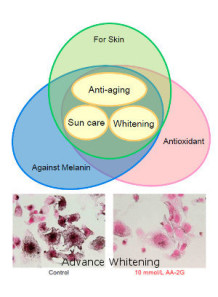Ascorbyl Glucoside (AA-2G Stabilized Vitamin C)
- Product Code: 265
Stable Vitamin C can be mixed in water immediately. Produced under the copyright process of Hayashibara, Japan. Effective in whitening and brightening the skin. and reducing free radicals Stimulates the synthesis of collagen in the skin.
- -
- -
- -
- -
- -
- -
- -
- -
- -
- -
- -
- -
- -
- -
- -
- -
- -
- -
| Test Name | Specification |
|---|---|
| Appearance | White to slight yellowish powder or crystalline / odorless |
| Identification (1) Ascorbic Acid | The regent colors disappear immediately |
| Identification (2) Reducing Sugars | Red Precipitate is formed |
| Identification (3) Infrared absorption | Specification absorbance shown at 3300,1770,1700,1110,1060cm-1 |
| Melting Point | 158-163 Degree Celsius |
| Specification Rotation (D20) | +186 to +188 Degree Celsius |
| Purity (1) Clarity of Solution | Clear |
| Purity (2) Color in Solution | Not more than 0.010 |
| Purity (3) Heavy Metals | Not more than 20ppm as Pb |
| Purity (4) Arsenic | Not more than 2ppm as As2O3 |
| Purity (5) Free ascorbic acid | Not more than 0.1% |
| Free Glucose | Not more than 0.1% |
| Loss on Drying | Not more than 1.0% |
| Residue on Ignition | Not more than 0.2% |
| Assay (L-Ascorbic acid 2-glucoside) | Not less than 98.0% |
Ascorbyl Glucoside or popularly called AA-2G is a stable type of vitamin C that can be mixed in water immediately. Synthesized by combining glucose sugar with L-Ascorbic Acid.
Effective in whitening and brightening the skin. and reducing free radicals Stimulates the synthesis of collagen in the skin.
Difference between normal L-Ascorbic Acid and Stabilized Vitamin C (AA-2G)
- AA2G™ is stable even in water. or heat at a level not exceeding 40 degrees, making it easy to use and mix
- AA2G™ has the ability to be absorbed into the skin as well as L-Ascorbic Acid, which is different from other Vitamin C derivatives such as Sodium Ascorbyl Phosphate (SAP) / Magnesium Ascorbyl Phosphate (MAP) which cannot be absorbed. easily into the skin
Figure 1: Comparing the stability of AA-2G and Vitamin C (L-Ascorbic Acid) in water. It was found that AA-2G is clearly more stable than L-Ascorbic Acid.
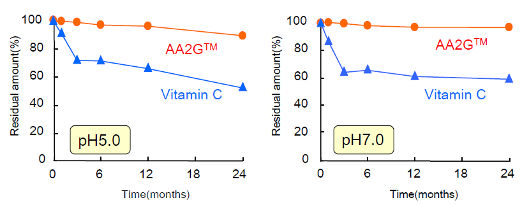
Figure 2: Comparing absorption into fibroblasts in the subcutaneous layer, it was found that AA2G™ can be continuously absorbed into the skin for a longer time. Even at a lower level than Vitamin C L-Ascorbic Acid in the beginning
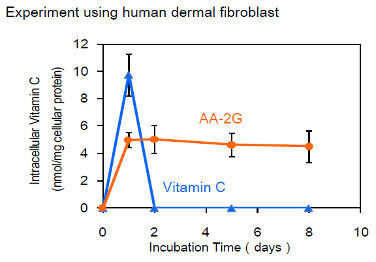
Figure 3: Compare the use of the skin. The skin can decompose AA2G™ and can be used easily, even compared to L-Ascorbic Acid that can be used immediately without the need to degrade further.
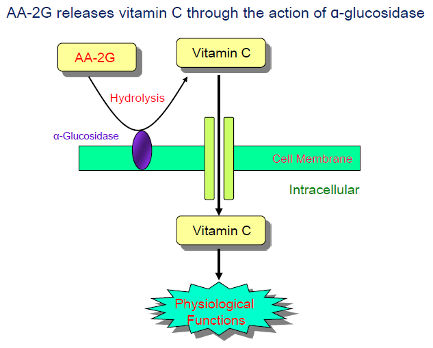
Figure 4: Comparison of the whitening efficiency of AA2G™ shows that Can help skin color fade.
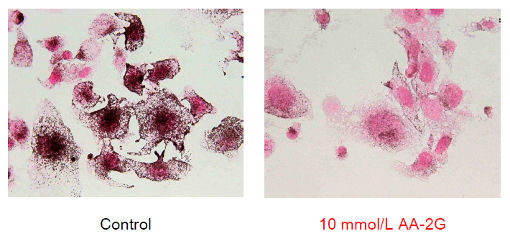
Mixing instructions:
AA2G will be highly acidic. When mixed in water But it is stable in the pH range of 6.5-6.8. Mixing must use a pH Meter to measure and adjust the pH to the appropriate level. Example of dissolving AA2G in water
In the process of dissolving AA2G into water, the pH of the liquid may drop very low. Due to the high acidity of AA2G, it is recommended to add Citrate Buffer as in the example below. To prevent AA2G from losing some quality. During the period under high acidity
Preparation of Citrate Buffer: Mix Citric Acid 1%, Sodium Citrate 15%, Water 84%.
Use Citrate Buffer at the same rate as AA2G in the recipe. For example, if you use 2% AA2G in your recipe, use 2% Citrate Buffer as well.
By mixing Citrate Buffer with water in the formula, then adding AA2G to the formula and measuring the pH, then adjusting the pH by adding an alkali such as TEA (Triethanolamone) or Sodium Hydroxide, which must be adjusted to keep the pH within the range of 6.5. -6.8, which will help make AA2G extremely stable.
If it is not convenient to prepare Citrate Buffer according to the instructions above, please use L-Arginine at a ratio of 1:2 (1 part L-Arginine to 2 parts AA2G). Mix well. Then dissolved in water at the same time. L-Arginine can help control the pH so that AA2G does not deteriorate.
The formula does not contain Safe-B3 or Zinc PCA as they will affect the stability of AA-2G.
Differences between each type of Vitamin C that the company sells:
1. Ethyl Ascorbic Acid : Vitamin C, soluble in water, highly stable, easy to mix, moderately effective. In terms of brightness (whitening)
2. Perfect-C™ (Ascorbyl Tetraisopalmitate) : Vitamin C dissolves in oil. Moderately stable High efficiency both sides wrinkles (anti-oxidant), radiance (whitening) and softness (collagen level) of the skin
3. Ascorbyl Glucoside (AA2G™, Stable Vitamin C) : Vitamin C is soluble in water and has moderate stability. Has a complex mixing process (pH level must be adjusted appropriately) and is highly effective in brightening (whitening) and wrinkles (anti-oxidant).
4. Vitamin C (L-ascorbic acid) Ultra-Fine , Vitamin C (L-ascorbic acid) Fine : Vitamin C dissolves in water, can dissolve in water very quickly and disperses very well. has low stability There are complicated mixing steps. High efficiency both sides wrinkles (anti-oxidant), radiance (whitening) and softness (collagen level) of the skin
5. Vitamin C (L-ascorbic acid) : Vitamin C is water soluble and has low stability. There are complicated mixing steps. High efficiency both sides wrinkles (anti-oxidant), radiance (whitening) and softness (collagen level) of the skin
6. Stabilized Vitamin C (Natural-C Glycol™) Serum : Ready-made vitamin C base, highly stable. But cannot adjust or add other ingredients. Because it will affect the stability of the bass. High efficiency both wrinkles (anti-oxidant), radiance (whitening) and softness (collagen level) of the skin
7. Magnesium Ascorbyl Phosphate (MAP) : Vitamin C, water soluble , highly stable, easy to mix, moderately effective. In terms of brightness (whitening)
8. Sodium Ascorbyl Phosphate (SAP) : Vitamin C, water soluble , highly stable, easy to mix, moderately effective. In terms of brightening (whitening), it is similar to MAP.
9. Vitamin C Ester (Ascorbyl Palmitate) : Oil-soluble vitamin C. Suitable for use as an anti-oxidant in oil formulas. It has little efficiency in other areas. Compared to other forms of Vitamin C
It is recommended to use Protec™ OX and Protec™ UV in the formula to help protect Vitamin C from quality deterioration.
Usage: Can be used in all types of Anti-Aging, whitening products such as in the form of gels, serums, lotions or creams.
Mixing method: Mix in water. The temperature of the cosmetic must be lower than 50 °C and the formula must have a pH in the range of 6.5-6.8. If it is outside this pH range, AA2G will deteriorate faster. Please see more details above.
Usage rate: 2-10%
Product appearance: white powder
Solubility: Can dissolve in water
Storage: For long-term storage Store in the refrigerator at 6 °C -8 °C. At least 1 year old
INCI Name : Ascorbyl Glucoside
Be the first to review this product :-)
Recent dicussion threads:
- › 2023-10-09 Check the ingredients
- › 2023-01-07 Ask about Papain.
- › 2020-07-15 ask to check ingredients The team doesn't have to answer.
Recommend Lab-Service
| Lab Service | Price |
|---|---|
| UV-VIS Ascorbyl Glucoside Content Measurement
Measurement of Ascorbyl Glucoside in finished product |
฿ 2,990.00 |
Stable Vitamin C can be mixed in water immediately. Produced under the copyright process of Hayashibara, Japan. Effective in whitening and brightening the skin. and reducing free radicals Stimulates the synthesis of collagen in the skin.
Ascorbyl Glucoside or popularly called AA-2G is a stable type of vitamin C that can be mixed in water immediately. Synthesized by combining glucose sugar with L-Ascorbic Acid.
Effective in whitening and brightening the skin. and reducing free radicals Stimulates the synthesis of collagen in the skin.
Difference between normal L-Ascorbic Acid and Stabilized Vitamin C (AA-2G)
- AA2G™ is stable even in water. or heat at a level not exceeding 40 degrees, making it easy to use and mix
- AA2G™ has the ability to be absorbed into the skin as well as L-Ascorbic Acid, which is different from other Vitamin C derivatives such as Sodium Ascorbyl Phosphate (SAP) / Magnesium Ascorbyl Phosphate (MAP) which cannot be absorbed. easily into the skin
Figure 1: Comparing the stability of AA-2G and Vitamin C (L-Ascorbic Acid) in water. It was found that AA-2G is clearly more stable than L-Ascorbic Acid.

Figure 2: Comparing absorption into fibroblasts in the subcutaneous layer, it was found that AA2G™ can be continuously absorbed into the skin for a longer time. Even at a lower level than Vitamin C L-Ascorbic Acid in the beginning

Figure 3: Compare the use of the skin. The skin can decompose AA2G™ and can be used easily, even compared to L-Ascorbic Acid that can be used immediately without the need to degrade further.

Figure 4: Comparison of the whitening efficiency of AA2G™ shows that Can help skin color fade.

Mixing instructions:
AA2G will be highly acidic. When mixed in water But it is stable in the pH range of 6.5-6.8. Mixing must use a pH Meter to measure and adjust the pH to the appropriate level. Example of dissolving AA2G in water
In the process of dissolving AA2G into water, the pH of the liquid may drop very low. Due to the high acidity of AA2G, it is recommended to add Citrate Buffer as in the example below. To prevent AA2G from losing some quality. During the period under high acidity
Preparation of Citrate Buffer: Mix Citric Acid 1%, Sodium Citrate 15%, Water 84%.
Use Citrate Buffer at the same rate as AA2G in the recipe. For example, if you use 2% AA2G in your recipe, use 2% Citrate Buffer as well.
By mixing Citrate Buffer with water in the formula, then adding AA2G to the formula and measuring the pH, then adjusting the pH by adding an alkali such as TEA (Triethanolamone) or Sodium Hydroxide, which must be adjusted to keep the pH within the range of 6.5. -6.8, which will help make AA2G extremely stable.
If it is not convenient to prepare Citrate Buffer according to the instructions above, please use L-Arginine at a ratio of 1:2 (1 part L-Arginine to 2 parts AA2G). Mix well. Then dissolved in water at the same time. L-Arginine can help control the pH so that AA2G does not deteriorate.
The formula does not contain Safe-B3 or Zinc PCA as they will affect the stability of AA-2G.
Differences between each type of Vitamin C that the company sells:
1. Ethyl Ascorbic Acid : Vitamin C, soluble in water, highly stable, easy to mix, moderately effective. In terms of brightness (whitening)
2. Perfect-C™ (Ascorbyl Tetraisopalmitate) : Vitamin C dissolves in oil. Moderately stable High efficiency both sides wrinkles (anti-oxidant), radiance (whitening) and softness (collagen level) of the skin
3. Ascorbyl Glucoside (AA2G™, Stable Vitamin C) : Vitamin C is soluble in water and has moderate stability. Has a complex mixing process (pH level must be adjusted appropriately) and is highly effective in brightening (whitening) and wrinkles (anti-oxidant).
4. Vitamin C (L-ascorbic acid) Ultra-Fine , Vitamin C (L-ascorbic acid) Fine : Vitamin C dissolves in water, can dissolve in water very quickly and disperses very well. has low stability There are complicated mixing steps. High efficiency both sides wrinkles (anti-oxidant), radiance (whitening) and softness (collagen level) of the skin
5. Vitamin C (L-ascorbic acid) : Vitamin C is water soluble and has low stability. There are complicated mixing steps. High efficiency both sides wrinkles (anti-oxidant), radiance (whitening) and softness (collagen level) of the skin
6. Stabilized Vitamin C (Natural-C Glycol™) Serum : Ready-made vitamin C base, highly stable. But cannot adjust or add other ingredients. Because it will affect the stability of the bass. High efficiency both wrinkles (anti-oxidant), radiance (whitening) and softness (collagen level) of the skin
7. Magnesium Ascorbyl Phosphate (MAP) : Vitamin C, water soluble , highly stable, easy to mix, moderately effective. In terms of brightness (whitening)
8. Sodium Ascorbyl Phosphate (SAP) : Vitamin C, water soluble , highly stable, easy to mix, moderately effective. In terms of brightening (whitening), it is similar to MAP.
9. Vitamin C Ester (Ascorbyl Palmitate) : Oil-soluble vitamin C. Suitable for use as an anti-oxidant in oil formulas. It has little efficiency in other areas. Compared to other forms of Vitamin C
It is recommended to use Protec™ OX and Protec™ UV in the formula to help protect Vitamin C from quality deterioration.
Usage: Can be used in all types of Anti-Aging, whitening products such as in the form of gels, serums, lotions or creams.
Mixing method: Mix in water. The temperature of the cosmetic must be lower than 50 °C and the formula must have a pH in the range of 6.5-6.8. If it is outside this pH range, AA2G will deteriorate faster. Please see more details above.
Usage rate: 2-10%
Product appearance: white powder
Solubility: Can dissolve in water
Storage: For long-term storage Store in the refrigerator at 6 °C -8 °C. At least 1 year old
INCI Name : Ascorbyl Glucoside
| Mechanism | - |
| Appearance | - |
| Longevity | - |
| Strength | - |
| Storage | - |
| Shelf Life | - |
| Allergen(s) | - |
| Dosage (Range) | - |
| Recommended Dosage | - |
| Dosage (Per Day) | - |
| Recommended Dosage (Per Day) | - |
| Mix Method | - |
| Heat Resistance | - |
| Stable in pH range | - |
| Solubility | - |
| Product Types | - |
| INCI | - |
Cart
No products



